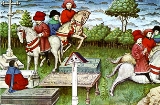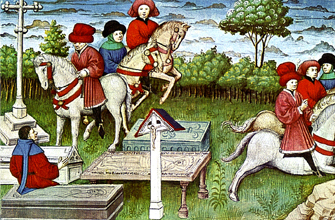
Palfrey
Encyclopedia

Horse
The horse is one of two extant subspecies of Equus ferus, or the wild horse. It is a single-hooved mammal belonging to the taxonomic family Equidae. The horse has evolved over the past 45 to 55 million years from a small multi-toed creature into the large, single-toed animal of today...
highly valued as a riding horse
Horses in the Middle Ages
Horses in the Middle Ages differed in size, build and breed from the modern horse, and were, on average, smaller. They were also more central to society than their modern counterparts, being essential for war, agriculture, and transport....
in the Middle Ages
Middle Ages
The Middle Ages is a periodization of European history from the 5th century to the 15th century. The Middle Ages follows the fall of the Western Roman Empire in 476 and precedes the Early Modern Era. It is the middle period of a three-period division of Western history: Classic, Medieval and Modern...
. It is not a breed.
The word "palfrey" is cognate with the German word for horse (of any type), "Pferd". Both descend from Latin "paraveredus", meaning a post horse or courier horse. The German term for a palfrey, meanwhile, is Zelter, which literally means "ambler
Ambling
The term amble or ambling is used to describe a number of four-beat intermediate gaits of horses. All are faster than a walk but usually slower than a canter or gallop...
" and is cognate with the Icelandic tölt.
Breeding
The term 'palfrey' usually referred to the most expensive and highly-bred types of riding horse during the Middle Ages, sometimes equalling the knight'sKnight
A knight was a member of a class of lower nobility in the High Middle Ages.By the Late Middle Ages, the rank had become associated with the ideals of chivalry, a code of conduct for the perfect courtly Christian warrior....
destrier
Destrier
The destrier is the best-known war horse of the medieval era. It carried knights in battles, tournaments, and jousts. It was described by contemporary sources as the Great Horse, due to its size and reputation....
in price. Consequently, it was popular with nobles, ladies and highly-ranked knights for riding, hunting
Medieval hunting
Throughout Western Europe in the Middle Ages, men hunted wild animals. While game was at times an important source of food, it was rarely the principal source of nutrition. Hunting was engaged by all classes, but by the High Middle Ages, the necessity of hunting was transformed into a stylized...
and ceremonial use.
Gait
The significant characteristic of the palfrey was that, rather than trottingTrot
A trot is a type of symmetrical gait in animals.Trot may also refer to:*Trot , the specifics of trotting in horses*Trot , a genre of Korean pop music*Trot , a character from the Oz books of L...
, it usually possessed a smooth, ambling
Ambling
The term amble or ambling is used to describe a number of four-beat intermediate gaits of horses. All are faster than a walk but usually slower than a canter or gallop...
gait. The amble was the name given to a group of smooth, four-beat gaits
Horse gait
Horse gaits are the various ways in which a horse can move, either naturally or as a result of specialized training by humans.-Classification:...
faster than a walk, but slower than a canter
Canter
The canter is a controlled, three-beat gait performed by a horse. It is a natural gait possessed by all horses, faster than most horses' trot but slower than the gallop, and is used by all riders. The speed of the canter varies between 16-27 km/h , depending on the length of the stride of the horse...
or gallop. The trot
Trot
A trot is a type of symmetrical gait in animals.Trot may also refer to:*Trot , the specifics of trotting in horses*Trot , a genre of Korean pop music*Trot , a character from the Oz books of L...
is a two-beat gait, about 8 mph, suitable for covering a lot of ground relatively quickly. However, the horse also has a bit of a spring in its motion as it switches diagonal pairs of legs with each beat, and thus can be rough for a rider
Equestrianism
Equestrianism more often known as riding, horseback riding or horse riding refers to the skill of riding, driving, or vaulting with horses...
, and jostles about packs or weaponry to a considerable degree. The amble is about as fast as the trot, not tiring for a horse that performs it naturally, and much smoother for the rider. Thus, because much ground transportation in the Middle Ages was on horseback, with long distances to be covered, a smooth-gaited horse was much desired.
An amble is achieved by the horse when it moves with a four-step rhythm, either derived from the two-beat lateral gait known as the pace
Horse gait
Horse gaits are the various ways in which a horse can move, either naturally or as a result of specialized training by humans.-Classification:...
or from the diagonal trot, with the two beats broken up so there are four. There are several variations, but most either have a lateral sequence of footfalls (left hind, left front, right hind, right front), or a diagonal sequence (left hind, right front, right hind, left front). In either case, only one foot is all the way off the ground at a time. Such a gait can be maintained for long distances, and sometimes at considerable speed.
Ambling horses are now uncommon in Europe. They were effectively replaced by trotting horses for several reasons. The first was that travel by carriage
Carriage
A carriage is a wheeled vehicle for people, usually horse-drawn; litters and sedan chairs are excluded, since they are wheelless vehicles. The carriage is especially designed for private passenger use and for comfort or elegance, though some are also used to transport goods. It may be light,...
became more common, and trotting horse breeds were generally larger and stronger, more suited to the job at hand. Another reason was the rise of the Thoroughbred
Thoroughbred
The Thoroughbred is a horse breed best known for its use in horse racing. Although the word thoroughbred is sometimes used to refer to any breed of purebred horse, it technically refers only to the Thoroughbred breed...
and other breeds developed for horse racing
Horse racing
Horse racing is an equestrian sport that has a long history. Archaeological records indicate that horse racing occurred in ancient Babylon, Syria, and Egypt. Both chariot and mounted horse racing were events in the ancient Greek Olympics by 648 BC...
and for light cavalry
Cavalry
Cavalry or horsemen were soldiers or warriors who fought mounted on horseback. Cavalry were historically the third oldest and the most mobile of the combat arms...
, both of which required horses able to gallop
Canter
The canter is a controlled, three-beat gait performed by a horse. It is a natural gait possessed by all horses, faster than most horses' trot but slower than the gallop, and is used by all riders. The speed of the canter varies between 16-27 km/h , depending on the length of the stride of the horse...
for substantial periods of time. Breeds swift at the gallop also tend to trot rather than pace or amble.
The smooth ambling gaits today have many names, including the single-foot, the stepping pace, the tolt, the rack, the paso corto, and the fox trot (see ambling
Ambling
The term amble or ambling is used to describe a number of four-beat intermediate gaits of horses. All are faster than a walk but usually slower than a canter or gallop...
). Though ambling horses are less common today than in the Middle Ages
Middle Ages
The Middle Ages is a periodization of European history from the 5th century to the 15th century. The Middle Ages follows the fall of the Western Roman Empire in 476 and precedes the Early Modern Era. It is the middle period of a three-period division of Western history: Classic, Medieval and Modern...
, there are still many ambling breeds, particularly in North America
North America
North America is a continent wholly within the Northern Hemisphere and almost wholly within the Western Hemisphere. It is also considered a northern subcontinent of the Americas...
where today they are referred to as gaited horse
Gaited horse
Gaited horses are horse breeds that have natural gaited tendencies, that is, the ability to perform one of the smooth to ride, intermediate speed four-beat horse gaits, collectively referred to as ambling gaits....
s. Some of these breeds include the Missouri Fox Trotter
Missouri Fox Trotter
The Missouri Fox Trotter is an American breed of horse with a unique four beat gait. It was bred in the Ozark Mountain foothills, and used by settlers who valued its smoothness.-Breed characteristics:...
, Tennessee Walking Horse, Icelandic horse
Icelandic horse
The Icelandic horse is a breed of horse developed in Iceland. Although the horses are small, at times pony-sized, most registries for the Icelandic refer to it as a horse. Icelandic horses are long-lived and hardy. In their native country they have few diseases; Icelandic law prevents horses from...
and a sub-group within the American Saddlebred
American Saddlebred
The American Saddlebred, formerly known as the American Saddle Horse, is a breed of horse that was developed in Kentucky by plantation owners. Today, in the horse show world, they are most commonly seen under saddle in Saddle seat style riding, and in various types of driving, including pleasure...
. The Paso Fino
Paso Fino
The Paso Fino is a naturally gaited light horse breed dating back to horses imported to the Caribbean from Spain. Pasos are prized for their smooth, natural, four beat, lateral ambling gait and are used in many disciplines, but are especially popular for trail riding...
and the Peruvian Paso
Peruvian Paso
The Peruvian Paso or Peruvian Horse is a breed of light pleasure saddle horse known for its smooth ride. It is distinguished by a natural, four-beat, lateral gait called the paso llano.-History:...
, breeds developed in Latin America
Latin America
Latin America is a region of the Americas where Romance languages – particularly Spanish and Portuguese, and variably French – are primarily spoken. Latin America has an area of approximately 21,069,500 km² , almost 3.9% of the Earth's surface or 14.1% of its land surface area...
, perform two or three different ambling gaits of varying speed, and are probably the closest modern descendants of the medieval palfrey.

